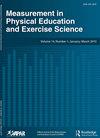Associations among Musculoskeletal Fitness Assessments and Health Outcomes: The Lisbon Study for the Development and Evaluation of Musculoskeletal Fitness Standards in Youth
IF 1.9
4区 教育学
Q2 EDUCATION & EDUCATIONAL RESEARCH
Measurement in Physical Education and Exercise Science
Pub Date : 2021-11-14
DOI:10.1080/1091367X.2021.2000414
引用次数: 8
Abstract
ABSTRACT This study summarized protocols in the Lisbon Study for the Development and Evaluation of Musculoskeletal Fitness Standards in Youth and assessed associations between fitness assessments and health outcomes. The sample was 529 children and adolescents (10 to 18 yr). The fitness assessments included handgrip, vertical jump, long jump, plank, and lower body power. The health outcomes were total body and hip bone mineral content, hip bone mineral density, and total body lean tissue mass. Correlation analyses examined associations unadjusted and adjusted for size and maturity. After adjustment, in females, vertical jump, long jump, and lower body power were associated with all health outcomes (r = 0.22 to 0.55, p < .05). In males, all fitness assessments were associated with all health outcomes (r = 0.17 to 0.64, p < .05). Musculoskeletal fitness assessments including non-invasive and easy-to-measure field assessments are associated with important muscle and bone health outcomes in youth.肌肉骨骼健康评估与健康结果之间的关系:青少年肌肉骨骼健康标准制定和评估的里斯本研究
摘要本研究总结了里斯本青年肌肉骨骼健康标准制定和评估研究的方案,并评估了健康评估与健康结果之间的关系。样本为529名儿童和青少年(10至18岁)。体能评估包括抓握、垂直跳跃、跳远、平板和下半身力量。健康结果为全身和髋骨矿物质含量、髋骨矿物质密度和全身瘦组织质量。相关分析检查了未经调整和根据大小和成熟度进行调整的相关性。调整后,在女性中,垂直跳跃、跳远和下半身力量与所有健康结果相关(r=0.22至0.55,p<.05)。在男性中,所有体能评估均与所有健康结果相关(r=0.17至0.64,p<.05)。肌肉骨骼体能评估,包括非侵入性和易于测量的实地评估,与青年重要的肌肉和骨骼健康结果相关。
本文章由计算机程序翻译,如有差异,请以英文原文为准。
求助全文
约1分钟内获得全文
求助全文
来源期刊

Measurement in Physical Education and Exercise Science
Medicine-Orthopedics and Sports Medicine
CiteScore
4.20
自引率
33.30%
发文量
24
期刊介绍:
The scope of Measurement in Physical Education and Exercise Science (MPEES) covers original measurement research, special issues, and tutorials within six substantive disciplines of physical education and exercise science. Six of the seven sections of MPEES define the substantive disciplines within the purview of the original research to be published in the journal: Exercise Science, Physical Activity, Physical Education Pedagogy, Psychology, Research Methodology and Statistics, and Sport Management and Administration. The seventh section of MPEES, Tutorial and Teacher’s Toolbox, serves to provide an outlet for review and/or didactic manuscripts to be published in the journal. Special issues provide an avenue for a coherent set of manuscripts (e.g., four to five) to collectively focus in-depth on an important and timely measurement-related issue within the scope of MPEES. The primary aim of MPEES is to publish high-impact manuscripts, most of which will focus on original research, that fit within the scope of the journal.
 求助内容:
求助内容: 应助结果提醒方式:
应助结果提醒方式:


